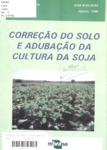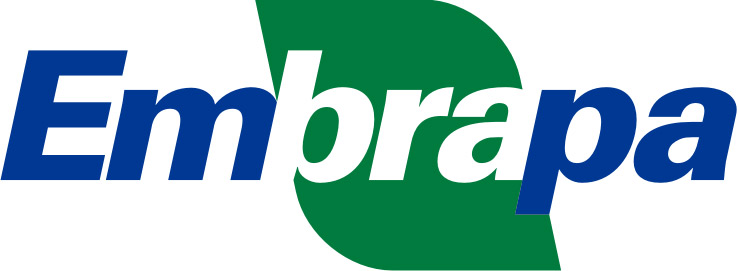Please use this identifier to cite or link to this item:
http://www.infoteca.cnptia.embrapa.br/infoteca/handle/doc/551684Full metadata record
| DC Field | Value | Language |
|---|---|---|
| dc.contributor.author | SOUSA, D. M. G. de | pt_BR |
| dc.contributor.author | LOBATO, E. | pt_BR |
| dc.date.accessioned | 2014-03-13T23:25:30Z | - |
| dc.date.available | 2014-03-13T23:25:30Z | - |
| dc.date.created | 1996-05-24 | pt_BR |
| dc.date.issued | 1996 | pt_BR |
| dc.identifier.citation | Planaltina, DF: EMBRAPA-CPAC, 1996. | pt_BR |
| dc.identifier.uri | http://www.infoteca.cnptia.embrapa.br/infoteca/handle/doc/551684 | pt_BR |
| dc.description | In order to grow soybeans in cerrado soils it is necessary a previous, reduction of soil acidity and to build up the soil fertility. It is recommended the application of limestone to raise the soil pH up to the range between 5,5 and 6,0 or to increase base saturation up to 50%. The chemical constraints for root growth in the subsurface soil layers, such as the high aluminum saturation and/or calcium defficiency, can be overcome by the addition of gypsum. The recomended levels of gypsum vary from 700 kg/ha for sandy soils to 3200 kg/ha for heavy clayey soils. Fertilizers to supply phosphorus and potassium are recommended according to their availability in the soil determined by chemical analysis. Critical levels for those nutrients as well as the fertilizers recommendations are presented and vary with soil clay content. Alternatives for these aplications are offered. As for the micronutrients, the fertilizers recommendations are based on their availability detected either by plant or soil analysis. The most common deficiency is related to zinc. There are, also, some indications for boron and copper defficiencies after a few years of cropping. | pt_BR |
| dc.format | 4 figuras, 5 tabelas. | pt_BR |
| dc.language.iso | por | pt_BR |
| dc.relation.ispartofseries | (EMBRAPA-CPAC. Circular Tecnica, 33). | pt_BR |
| dc.rights | openAccess | pt_BR |
| dc.subject | Micronutriente | pt_BR |
| dc.subject | Avaliacao | pt_BR |
| dc.subject | Aspecto economico | pt_BR |
| dc.subject | Phosphate fertilizers | pt_BR |
| dc.subject | Potash fertilizers | pt_BR |
| dc.subject | Micronutrient fertilizers | pt_BR |
| dc.subject | Evaluation | pt_BR |
| dc.subject | Economic situation | pt_BR |
| dc.title | Correção do solo e adubação da cultura da soja. | pt_BR |
| dc.type | Folhetos | pt_BR |
| dc.date.updated | 2014-03-13T23:25:30Z | pt_BR |
| dc.subject.thesagro | Acidez do Solo | pt_BR |
| dc.subject.thesagro | Adubação | pt_BR |
| dc.subject.thesagro | Calagem | pt_BR |
| dc.subject.thesagro | Cerrado | pt_BR |
| dc.subject.thesagro | Fertilidade do Solo | pt_BR |
| dc.subject.thesagro | Fertilizante Fosfatado | pt_BR |
| dc.subject.thesagro | Fertilizante Nitrogenado | pt_BR |
| dc.subject.thesagro | Fertilizante Potássico | pt_BR |
| dc.subject.thesagro | Glycine Max | pt_BR |
| dc.subject.thesagro | Microelemento | pt_BR |
| dc.subject.thesagro | Oxisol | pt_BR |
| dc.subject.thesagro | Soja | pt_BR |
| dc.subject.nalthesaurus | Ferralsols | pt_BR |
| dc.subject.nalthesaurus | acid soils | pt_BR |
| dc.subject.nalthesaurus | fertilizer application | pt_BR |
| dc.subject.nalthesaurus | liming | pt_BR |
| dc.subject.nalthesaurus | nitrogen fertilizers | pt_BR |
| dc.subject.nalthesaurus | soil fertility | pt_BR |
| dc.subject.nalthesaurus | soybeans | pt_BR |
| dc.subject.nalthesaurus | trace elements | pt_BR |
| dc.format.extent2 | 30p. | pt_BR |
| riaa.ainfo.id | 551684 | pt_BR |
| riaa.ainfo.lastupdate | 2014-03-13 | pt_BR |
| Appears in Collections: | Circular Técnica (CPAC)  | |
Files in This Item:
| File | Description | Size | Format | |
|---|---|---|---|---|
| cirtec33.pdf | 1,33 MB | Adobe PDF |  View/Open |









